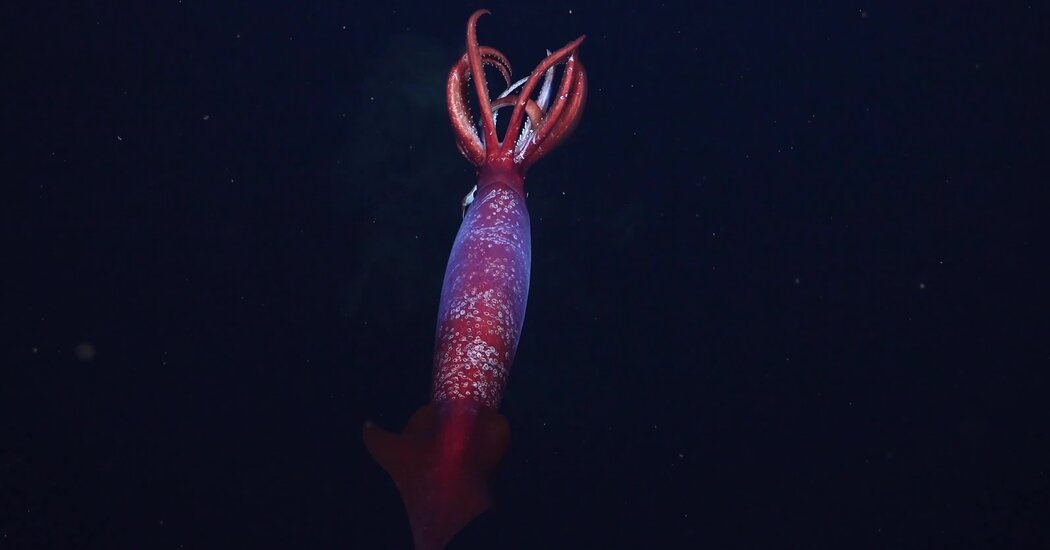The deep sea environs of land poles are home to the mysterious ocean creature: giant sea spiders, Antarctic Sea Pigs, Phantom Jellyfish. Finding and recognizing these animals can be difficult, however; Some are only known because researchers have found their lips in fishing nets or in the bellies of seabirds. But on Christmas day last year, the crew of R/V Falkor (too), the Schmidt Ocean Institute’s Research Vessel, was caught by an unseen creature.
The team plans to deploy its remotely operated vehicle, Subastian, to a site known as the Powell Basin, but the movement of ice blocks forced the group to explore the external edges of the region.
When the submersible dropped 7,000 feet, the team unexpectedly saw a shadow by live feed, which became an Antarctic gonate squid, a rare species of cephalopod, three feet long and releasing a green cloud of ink.
“It’s a beautiful squid,” said Andrew Thurber, a deep-sea researcher at the University of California, Santa Barbara, riding in the vessel. “You see beauty all the time in the deep ocean, and it’s a classic example of it.”
No Antarctic Gonate Squid has been seen alive before, to the team’s consciousness. They followed it for a few minutes and made sure to record it in the video, get the red color of the creature and white areas.
“Videos like this are really excited for me,” said Linsey Sala, a museum scientist in charge of the pelagic invertebrate collection at the Scripps Institution of Oceanography and not involved in the expedition. Discoveries of species like these “can be a real knowledge of how they live in great depths,” Ms. Living room. Anonymous specimens can sit in collections around the world, he added, where video footage can help reveal what they are.
The past sights of this species of squid are limited to individuals caught by fishing vessels and squid remains found in other sea animals, mostly Falkland islands.
“It’s always been anxious to see the live footage of a critter known only from dead specimens before,” said Bruce Robison, a deep sea ecology at the Monterey Bay Aquarium Research Institute who was also not involved in the expedition.
For those aboard the vessel, the discovery is “thin love,” said Dr. Thurber. There was a fever of excitement even before they could properly identify the squid. To prove the species, Dr. Thurber and his colleagues are immersed by the vehicle underwater by taxonomists around the world.
Kat Bolstad, a Cephalopod biologist at the Auckland University of Technology in New Zealand, helped identify the animal. The sex and age of the squid is difficult to determine, but the single hook in each tent, seen by the images sent to him, has confirmed that the species is gonatus Antarcticus.
The hooks can be the benefit of the victim’s secure and latching, a characteristic shared with other squids. The squid also has scratches on its arms and sucker marks on its mantle, perhaps from a recent attack by another sea creature.
Deep sea squids are difficult to find and document. The conduct of the thousands of feet under the sea surface is challenging and expensive, and animals tend to avoid distant operated vehicles, which are often noisy and bright. These vehicles are “foreigners of deep,” Dr. Thurber. “So it really depends on them to come and look at us.”
This particular dive is part of The National Geographic and Rolex Perpetual Planet Expedition, an initiative to document climate change in mountains, rainforests and oceans.
This is not the first elusive squid that the Subastian, the distant operated vehicle. This year, will also be submitted Caught a massive squid Mesonychoteuthis Hamiltoni, a century after the animal was first described in a scientific sheet.
But less is known about the Antarctic Gonate Squid, which lives in the water of the Southern Ocean and Spawns at the bottom below 2,000 feet.
Penguins in the region are known to festival with Antarctic gonate squid – smaller. They were also seized by the colosal squid, which shares both depths and water.
Discovery promises to light the lives of Antarctic Gonate Squids and sets more questions. How far are these squids moving? How big is their range? What do they feed in the depths? How many grows?
“We know about the community that can have all the things that happen that we can only wonder,” Dr. Robison.

